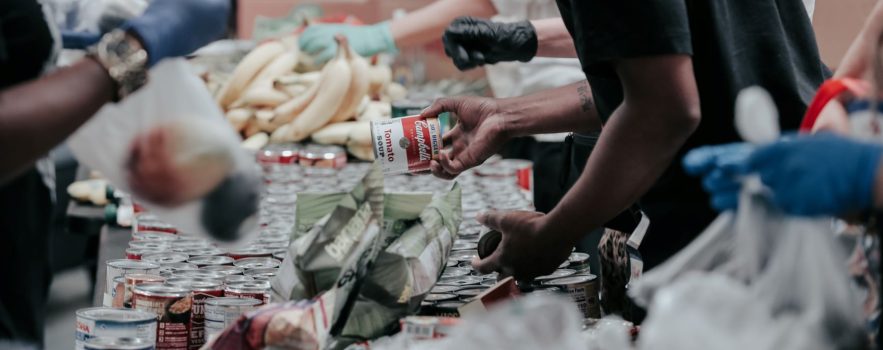Amy Yau, Jean Adams & Martin White
Headlines on ‘Food Bank Britain’ have featured increasingly in our newspapers since the global financial crash in 2008, documenting the struggle of many people who rely on emergency food aid to feed themselves and their families.
The use of food banks is a last resort for people facing food insecurity (or food poverty). And seeking sustenance from a food bank is the tip of a much bigger iceberg – a symptom of deep-rooted food insecurity. But the UK has made remarkably little effort to formally measure food insecurity in the population as a whole. Without measurement and monitoring, it is difficult to say just how much of a problem food insecurity is in the UK. And that, of course, makes it easier to ignore.
Food insecurity is often defined as lacking physical, social or economic access to enough healthy and nutritious food to support an active and healthy life. A common measure of food insecurity is the Household Food Security Survey Module, which measures food insecurity in adults, children, or combined as a household. This tool was developed in the US and has been used in many high-income countries, but rarely in large samples in the UK.
Food insecurity affected a quarter of UK adults in 2017
In our new paper published in Public Health Nutrition1 we used the adult version of this tool to survey 2,551 adults aged 18–64 years living in the UK. Our results indicate that almost one in four UK adults (24.3%) lived in food insecurity at some point in 2017.
We found that people who reported that making ends meet was difficult were around 20 times more likely to experience food insecurity. Families with children – and particularly single-parent households – were also much more likely to be living in food insecurity (49% of food insecure adults lived with children vs. 28% of food secure adults), as were younger adults and students.
Food insecurity is unlikely to be a healthful experience
Food insecurity has negative consequences for diet and health. Fruit and vegetables are often relatively expensive, and a common coping strategy for food insecurity is to turn to cheap foods that make you feel full without necessarily providing a balanced diet. This in turn leads to poorer quality diets, often together with increased calorie intake. In our study, people living with food insecurity were less likely to eat fruit and vegetables regularly and less likely to think their diet was healthy.
We also found that food insecurity was associated with poorer health outcomes. Compared to food secure adults, people living with food insecurity reported higher rates of stress (37% vs. 14%) and poor mental health (40% vs. 22%). These findings support previous studies that found food insecurity and food bank use to be stigmatising, isolating and shameful.2,3
COVID-19, far from a great leveller
Our study found that food insecurity was common before the COVID-19 pandemic, but other recent research indicates that the current situation has likely exacerbated the problem. A survey undertaken for the Food Foundation estimated that 8.1 million people experienced food insecurity during the first 3 weeks of lockdown.4,5
In addition to the problem of insufficient income, which for many is more uncertain than ever as businesses close and staff are laid off or furloughed, the pandemic has added a problem of limited food access. Concerns about inconsistent food supplies associated with panic buying are common, and many more vulnerable individuals are being asked to self-isolate and so may be unable to leave the house for grocery shopping. The pandemic is therefore likely to be adding to existing inequalities, disproportionately affecting those who were most at risk of food insecurity in the first place, including those with pre-existing health conditions and disabilities, as well as placing new people at risk of food insecurity.
Time for a new and better normal
While many hope that much of normal life will resume once this pandemic passes, our findings suggest that ‘normal’ will still leave almost one in four UK adults experiencing food insecurity.
Unemployment and delayed social benefit payments are frequently cited reasons for using food banks. However, food insecurity is not just a problem among unemployed individuals. The majority (76%) of food insecure adults in our study were employed. However, people working full-time on the National Living Wage do not necessarily achieve the Minimum Income Standard – the wage proposed by the Joseph Rowntree Foundation for individuals to reach a minimum socially acceptable standard of living.6
Current interventions to reduce food insecurity rely heavily on charity-funded emergency food aid such as food banks. Whilst these initiatives are helpful in reducing immediate hunger, we must look to improving incomes so that all members of society can afford a healthy and nutritious diet. Many of the changes needed to address the problem of food insecurity may take a long time to implement. Our work has highlighted that ending food insecurity is a huge challenge with important health and social consequences that needs to be addressed urgently.
References
- Yau A, White M, Hammond D, White C, Adams J. Sociodemographic characteristics, diet, and health among food insecure UK adults: cross-sectional analysis of the International Food Policy Study. Public Health Nutr. 2020. doi:10.1017/S1368980020000087
- Purdam K, Garratt EA, Esmail A. Hungry? Food Insecurity, Social Stigma and Embarrassment in the UK. Sociology. 2016;50(6):1072-1088. doi:10.1177/0038038515594092
- Garthwaite K. Stigma, shame and “people like us”: an ethnographic study of foodbank use in the UK. J Poverty Soc Justice. 2016;24(3):277-289. doi:10.1332/175982716X14721954314922
- The Food Foundation. Three million people are going hungry just three weeks into lockdown. 2020.
- Loopstra R. Vulnerability to Food Insecurity since the COVID-19 Lockdown – Preliminary Report (PDF). London; 2020.
- Davis A, Hirsch D, Padley M, et al. A Minimum Income Standard for the UK Continuity and Change and Change (PDF). York: Joseph Rowntree Foundation; 2018.

 MRC Epidemiology Unit
MRC Epidemiology Unit